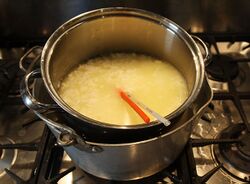Home-made Cheddar cheese
This recipe requires preparation in advance!
This turned out to be quite successful homemade cheese recipe, though it was eaten before it matured properly!
Use a double-boiler or you will scald the milk and spoil the taste of the cheese. See here for ideas on how to improvise one.
It is vital that you don't exceed any of the stated temperatures or your cheese will fail.
| Home-made Cheddar cheese | |
|---|---|
 |
| Stripy-shirt Cheddar | |
| Servings: | Servings: 20 - Too much for my small mould! |
| Calories per serving: | 99 |
| Ready in: | 6 hours |
| Prep. time: | 6 hours plus maturation period |
| Cook time: | None |
| Difficulty: | |
| Recipe author: | Chef |
| First published: | 14th October 2012 |
|
Best recipe reviewSo rewarding! 5/5 Making this gave me a real feeling of accomplishment! Amazing. |
Ingredients
Printable 🖨 shopping 🛒 list & 👩🍳 method for this recipe
- 7 pints full-cream milk
- ¼ teaspoon freeze dried DVI starter
- * I used a generic Ascott starter.
- 8 drops rennet
- 1 tablespoon sea salt
Mise en place
- Sterilise all equipment
Method
- Warm the milk to 32° C (90° F)
- Mix ¼ teaspoons of freeze dried DVI starter with 4 tablespoons of lukewarm water.
- Whisk into the milk and stir really well so it is properly mixed.
- Cover and leave for 1 hour.
- Mix 8 drops of rennet with 4 tablespoons lukewarm water and whisk into the milk. Stir really well so it is properly mixed.
- Leave for 2 hours for the milk to solidify.
- Cut the curds with a long knife into 5 mm (1/4") cubes.
- Leave to rest for 20 minutes.
- In a double boiler, heat the outer water to 39° C (102° F), using extra heat to keep this temperature stable, and stir the curds regularly until they reach 39° C (102° F). Stir regularly and don't overheat or the curds will melt together and you'll end up with mozzarella cheese!
- Once the curd temperature is stable at 39° C (102° F), cook the curds for another 45 minutes. As before, stabilise by using a little extra heat - you won't need much. Stir regularly to prevent the curds knitting together. A spring-type whisk (pictured) works well for this.
- Drain the curds in a cheesecloth lined colander.
- Add them back to the double boiler, stir well with a whisk to break up the curds and cook for another 45 minutes at 39° C (102° F).
- Sprinkle in the sea salt and mix well.
- Place the curds in a cheesecloth lined cheese mould and press with a 9kg (20 lbs) weight for 45 minutes.
- Take the cheese out of the cheese mould and turn it round.
- Press it again with 22 kg (50 lb) for 24 hours.
- Remove from the cheese press and dry for 5 days at room temperature.
- Wrap in a sterilised cheesecloth, seal the Cheddar with a flour and water paste and mature for 3 to 24 months
- Unless you have a cave handy, the fridge is probably the best place to mature your homemade cheese although it's really going to be too cold. After discovering the top shelf of my often-opened fridge could be as much as 5° C warmer than the bottom, I've decided to mature my cheeses there. As all fridges differ, check various areas of your fridge with a thermometer to find the area that is around 11°C [51° F], the ideal 'cave' temperature.
- Ideally hard cheeses should be left to mature for up to 3 months or more and turned regularly; however, if you don't have the patience to wait that long for your home-made cheese you will find the results of a young cheese perfectly acceptable.
-
Cooking the curds, second stage
-
Improvised double boiler
Discover Cookipedia's Culinary Creations on Pinterest
Explore the vibrant world of Cookipedia through our Pinterest page! We've curated a stunning collection of recipes that highlight the beauty of home-cooked dishes. It's the perfect way to visually navigate our extensive recipe library and get inspired by the flavours we’ve shared over the years. Dive in and discover your next favorite meal—one picture at a time!
#curds #cheesecloth #cheese #homemadecheddarcheese #cheesemould #doubleboiler #curd #cheddar #flour #dvistarter #cutthecurds

